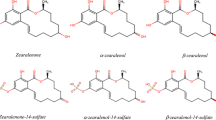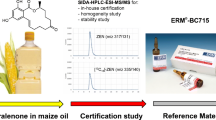Abstract
A certified reference material (CRM, KRISS 108-01-002) for zearalenone in corn flour was developed to assure reliable and accurate measurements in testing laboratories. Commercially available corn flour underwent freeze-drying, pulverization, sieving, and homogenization. The final product was packed in amber bottles, approximately 14 g per unit, and preserved at –70 °C. 13C18-Zearalenone was used as an internal standard (IS) for the certification of zearalenone by isotope-dilution liquid chromatography-tandem mass spectrometry (ID-LC‒MS/MS) and for the analysis of α-zearalenol, β-zearalenol, and zearalanone by LC‒MS/MS. The prepared CRM was sufficiently homogeneous, as the among-unit relative standard deviation for each mycotoxin ranged from 2.2 to 5.7 %. Additionally, the stability of the mycotoxins in the CRM was evaluated under different temperature conditions and scheduled test periods, including storage at −70°C, −20°C, and 4°C and room temperature for up to 12 months, 6 months, and 1 month, respectively. The content of each target mycotoxin in the CRM remained stable throughout the monitoring period at each temperature. Zearalenone content (153.6 ± 8.0 µg/kg) was assigned as the certified value. Meanwhile, the contents of α-zearalenol (1.30 ± 0.17 µg/kg), β-zearalenol (4.75 ± 0.33 µg/kg), and zearalanone (2.09 ± 0.16 µg/kg) were provided as informative values.




Similar content being viewed by others
References
Gab-Allah MA, Choi K, Kim B. Development of isotope dilution-liquid chromatography/tandem mass spectrometry for the accurate determination of type-A trichothecenes in grains. Food Chem. 2021;344:128698. https://doi.org/10.1016/j.foodchem.2020.128698.
Romero-Sánchez, I., et al., Simultaneous determination of aflatoxins B1, B2, G1 and G2 in commercial rices using immunoaffinity column clean-up and HPLC-MS/MS. Food Chem. 2022. 395:133611. https://doi.org/10.1016/j.foodchem.2022.133611
Gab-Allah MA, Choi K, Kim B. Type B trichothecenes in cereal grains and their products: recent advances on occurrence, toxicology, analysis and post-harvest decontamination strategies. Toxins. 2023;15(2):85. https://doi.org/10.3390/toxins15020085.
Abrunhosa L, et al. A review of mycotoxins in food and feed products in Portugal and estimation of probable daily intakes. Critical reviews in food science and nutrition. 2016;56(2):249–65. https://doi.org/10.1080/10408398.2012.720619.
Riedel J, et al. Development and certification of a reference material for zearalenone in maize germ oil. Analy Bioanaly Chem. 2021;413:5483–91. https://doi.org/10.1007/s00216-021-03532-z.
Moya-Cavas T, et al, Simultaneous determination of zearalenone and alternariol mycotoxins in oil samples using mixed molecularly imprinted polymer beads. Food Chem.2023; 135538. https://doi.org/10.1016/j.foodchem.2023.135538
Gab-Allah MA, Choi K, Kim B. Accurate determination of type B trichothecenes and conjugated deoxynivalenol in grains by isotope dilution–liquid chromatography tandem mass spectrometry. Food Control. 2021;121:107557. https://doi.org/10.1016/j.foodcont.2020.107557.
Moretti A, Pascale M, Logrieco AF. Mycotoxin risks under a climate change scenario in Europe. Trends Food Sci Technol. 2019;84:38–40. https://doi.org/10.1016/j.tifs.2018.03.008.
Maragos C. Zearalenone occurrence and human exposure. World Mycotoxin J. 2010;3(4):369–83. https://doi.org/10.3920/WMJ2010.1240.
Ropejko K, Twarużek M. Zearalenone and its metabolites—general overview, occurrence, and toxicity. Toxins. 2021;13(1):35. https://doi.org/10.3390/toxins13010035.
Ouakhssase A, et al. Optimization and validation of a liquid chromatography/tandem mass spectrometry (LC-MS/MS) method for the determination of aflatoxins in maize. Heliyon. 2019;5(5):e01565. https://doi.org/10.1016/j.heliyon.2019.e01565.
El-Sayed RA, et al. An overview on the major mycotoxins in food products: characteristics, toxicity, and analysis. J Future Foods. 2022;2(2):91–102. https://doi.org/10.1016/j.jfutfo.2022.03.002.
Lijalem YG, et al., Occurrence of zearalenone and its major metabolites in cereal flour from Korea. Food Additives Contaminants: Part A, 2023; 1-13. https://doi.org/10.1080/19440049.2023.2195956
Rogowska A, et al. Zearalenone and its metabolites: effect on human health, metabolism and neutralisation methods. Toxicon. 2019;162:46–56. https://doi.org/10.1016/j.toxicon.2019.03.004.
EFSA, Risks for animal health related to the presence of zearalenone and its modified forms in feed. EFSA J. 2017;15(7):e04851.
Bryła M, et al. Modified Fusarium mycotoxins in cereals and their products—metabolism, occurrence, and toxicity: An updated review. Molecules. 2018;23(4):963. https://doi.org/10.3390/molecules23040963.
Lijalem YG, et al. Development of isotope dilution-liquid chromatography/tandem mass spectrometry for the accurate determination of zearalenone and its metabolites in corn. Food Chem. 2022;384:132483. https://doi.org/10.1016/j.foodchem.2022.132483.
Mahato DK, et al. Occurrence, impact on agriculture, human health, and management strategies of zearalenone in food and feed: a review. Toxins. 2021;13(2):92. https://doi.org/10.3390/toxins13020092.
De Rycke E, et al. Recent advances in electrochemical monitoring of zearalenone in diverse matrices. Food Chem. 2021;353:129342. https://doi.org/10.1016/j.foodchem.2021.129342.
Pascari X, et al. Detection and quantification of zearalenone and its modified forms in enzymatically treated oat and wheat flour. J Food Sci Technol. 2023;60(4):1367–75. https://doi.org/10.1007/s13197-023-05683-6.
Jing S, et al., Toxicity of zearalenone and its nutritional intervention by natural products. Food Func. 2022;13(20):10374-10400. https://doi.org/10.1039/D2FO01545E
Commision E. Commission Regulation (EC) No 1881/2006 of 19 December 2006 setting maximum levels for certain contaminants in foodstuff. Off J Eur Union L. 2006;364:5–24.
Zhang S, et al. Human dietary and internal exposure to zearalenone based on a 24-hour duplicate diet and following morning urine study. Environ Int. 2020;142:105852. https://doi.org/10.1016/j.envint.2020.105852.
Xu S, et al. Lateral flow immunoassay based on polydopamine-coated gold nanoparticles for the sensitive detection of zearalenone in maize. ACS Appli Mater Inter. 2019;11(34):31283–90. https://doi.org/10.1021/acsami.9b08789.
Du H, et al. Determination of deoxynivalenol, zearalenone, aflatoxin B1, and ochratoxin by an enzyme-linked immunosorbent assay. Analytic Lett. 2014;47(11):1912–20. https://doi.org/10.1080/00032719.2014.891125.
Sun Y, et al. A fluorescent paper biosensor for the rapid and ultrasensitive detection of zearalenone in corn and wheat. Analytic Meth. 2021;13(35):3970–7. https://doi.org/10.1039/D1AY01149A.
Zhang X, et al. Determination of zearalenone in traditional Chinese medicinal plants and related products by HPLC–FLD. Food Additives Contam: Part A. 2011;28(7):885–93. https://doi.org/10.1080/19440049.2011.563429.
Hsieh HY, et al. Liquid chromatography incorporating ultraviolet and electrochemical analyses for dual detection of zeranol and zearalenone metabolites in mouldy grains. J Sci Food Agricult. 2012;92(6):1230–7. https://doi.org/10.1002/jsfa.4687.
Andrade PD, et al. Determination of multi-mycotoxins in cereals and of total fumonisins in maize products using isotope labeled internal standard and liquid chromatography/tandem mass spectrometry with positive ionization. J Chromatograp A. 2017;1490:138–47. https://doi.org/10.1016/j.chroma.2017.02.027.
Berthiller F, et al. Rapid simultaneous determination of major type A-and B-trichothecenes as well as zearalenone in maize by high performance liquid chromatography–tandem mass spectrometry. J Chromatograp A. 2005;1062(2):209–16. https://doi.org/10.1016/j.chroma.2004.11.011.
Wu Z, et al., Amphiphilic polymers facilitated solid phase extraction coupled with ultra‐performance liquid chromatography‐tandem mass spectrometry for direct extraction and analysis of zearalenone and zearalanone in corn juice samples. Journal of Separation Science, 2023:2300112. https://doi.org/10.1002/jssc.202300112
Hyung S-W, Lee C-H, Kim B. Development of certified reference materials for accurate determination of fluoroquinolone antibiotics in chicken meat. Food Chem. 2017;229:472–8. https://doi.org/10.1016/j.foodchem.2017.02.112.
Lee J, et al. Development of an infant formula certified reference material for the analysis of organic nutrients. Food Chem. 2019;298:125088. https://doi.org/10.1016/j.foodchem.2019.125088.
Ahn S, et al. Development of a lyophilized soybean paste certified reference material for the analysis of ochratoxin A. J Food Composit Analy. 2016;52:68–73. https://doi.org/10.1016/j.jfca.2016.08.002.
Gab-Allah MA, et al. Development of a certified reference material for the accurate determination of type B trichothecenes in corn. Food Chem. 2023;404:134542. https://doi.org/10.1016/j.foodchem.2022.134542.
Kim B-J, et al. Development of a model system of uncertainty evaluations for multiple measurements by isotope dilution mass spectrometry: determination of folic acid in infant formula. Bull Korean Chem Soc. 2010;31(11):3139–44. https://doi.org/10.5012/bkcs.2010.31.11.3139.
Krska R, et al. Preparation and certification of zearalenone mass concentration of two low-level maize reference materials. J AOAC Int. 2004;87(4):892–908. https://doi.org/10.1093/jaoac/87.4.892.
Krska*, R, et al., Zearalenone in maize: stability testing and matrix characterisation of a certified reference material. Food Add Contaminants, 2003. 20(12):1141-1152 https://doi.org/10.1080/02652030310001615203
Phillips MM et al., Development and characterization of a multimycotoxin reference material. 2019, Oxford University Press: 1642-1650. https://doi.org/10.1093/jaoac/102.6.1642
Gab-Allah MA, et al. Accurate determination of four tetracycline residues in chicken meat by isotope dilution-liquid chromatography/tandem mass spectrometry. J Chromatography A. 2023;1691:463818. https://doi.org/10.1016/j.chroma.2023.463818.
ISO Guide 35, I., 35: 2017 (2017) Reference materials—guidance for characterization and assessment of homogeneity and stability. International Organization for Standardization. Geneva, Switzerland, 2017.
Funding
This study was supported by the Korea Research Institute of Standards and Science under the project “Establishing measurement standards for organic analysis” (Grant no. 22011072). The funding source had no further detailed involvement in this study.
Author information
Authors and Affiliations
Contributions
Yared Getachew Lijalem: Methodology; investigation; data curation; formal analysis; writing, original draft; writing, review and editing
Mohamed A. Gab-Allah: Methodology, investigation.
Hyeonwoo Yu: Methodology, investigation.
Kihwan Choi: Conceptualization, resources, supervision, investigation, data curation, formal analysis, writing—review and editing
Byungjoo Kim: Conceptualization, project administration, supervision, investigation, data curation, formal analysis, writing—review and editing
Corresponding authors
Ethics declarations
Competing interests
The authors declare no competing interests.
Additional information
Publisher's Note
Springer Nature remains neutral with regard to jurisdictional claims in published maps and institutional affiliations.
Supplementary Information
Below is the link to the electronic supplementary material.
Rights and permissions
Springer Nature or its licensor (e.g. a society or other partner) holds exclusive rights to this article under a publishing agreement with the author(s) or other rightsholder(s); author self-archiving of the accepted manuscript version of this article is solely governed by the terms of such publishing agreement and applicable law.
About this article
Cite this article
Lijalem, Y.G., Gab-Allah, M.A., Yu, H. et al. Development of a corn flour certified reference material for the accurate determination of zearalenone. Anal Bioanal Chem 416, 3173–3183 (2024). https://doi.org/10.1007/s00216-024-05265-1
Received:
Revised:
Accepted:
Published:
Issue Date:
DOI: https://doi.org/10.1007/s00216-024-05265-1




